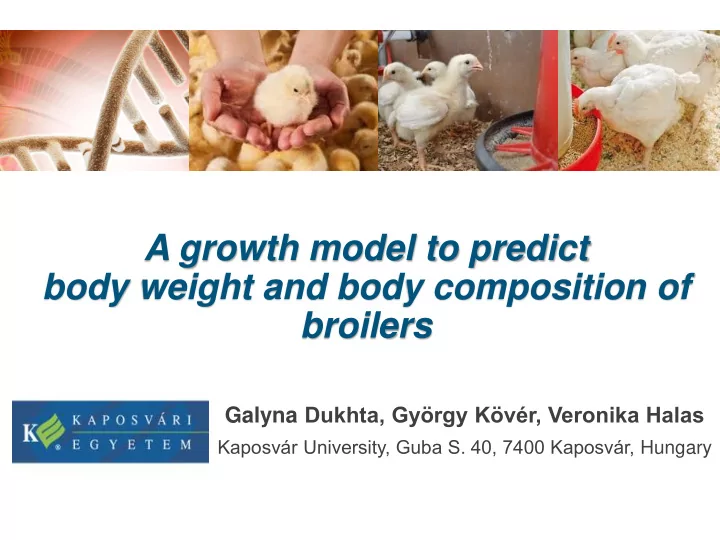

A growth model to predict body weight and body composition of broilers Galyna Dukhta, György Kövér, Veronika Halas Kaposvár University, Guba S. 40, 7400 Kaposvár, Hungary
Introduction Growth models have been developed for decades Static table values vs dynamic model values Aim To introduce a broiler growth model predicting BW and chemical body composition from digestible nutrients To show some application of the model
Flow chart FI digProtein/AAs digFat digStarch digSugar digResidue Endogenous ME intake losses PD PD-free NE available genetics Maintenance & LD Cost of PD physical activity Feather FFBP Feather loss Empty body lipid Empty body protein BW
Factors for energy conversion Feed Intake Gamma function NEI (MJ/d) = (a ·b·BW·exp( -b ·BW )+1 )·c· BW d a & b – depending on FI at 1 and 2 kg BW Carré et al., 2014 Coef Coef Coef Broiler Values InraPorc model ME AMEn NE kJ/g c 0.75 0.8 CrudeFat 38.38 37.77 32.43 d 0.6 0.7 CrudeProt 20.60 18.36 14.32 Starch 17.00 16.67 13.28 Sugars 13.02 12.52 7.932 Residue 9.93 9.30 12.71
Sophisticated Gompertz function for daily body protein deposition (PD) Wt = Wm · exp [-exp ((ln (-ln (Wi/Wm)) – (B · t)))] Pt = Pm · exp [-exp ((ln (-ln (Pi/Pm)) – (Bprot · t)))] 1,400 1,200 1,000 Protein mass, kg 0,800 0,600 0,400 0,200 0,000 0 20 40 60 80 100 Age ,d
Sophisticated Gompertz function for daily body protein deposition (PD) Wt = Wm · exp [-exp ((ln (-ln (Wi/Wm)) – (B · t)))] Pt = Pm · exp [-exp ((ln (-ln (Pi/Pm)) – (Bprot · t)))] Potential PD = precocity · prot_init ·ln (Pm/prot_init) 1,400 20,0 1,200 Protein mass, kg 15,0 1,000 PD, g/d 0,800 10,0 0,600 0,400 5,0 0,200 0,000 0,0 0 20 40 60 80 100 Age, d Protein mass, kg potPD, g/d
Model output The effect of precocity on dynamics of BW The effect of meanPD on dynamics of BW 3,5 3,5 3 3 2,5 2,5 BW, kg 2 BW, kg 2 1,5 1,5 1 1 0,5 0,5 0 0 0 10 20 30 40 0 10 20 30 40 Age, d Age, d 0,03 0,039 0,055 9 11 13,5 Body weight (BW) prediction for fixed mean PD (11 g/d) and different precocity parameter (left) and for fixed precocity (0.040) and different mean PD with (right)
Nutritional composition of the diets 3 phases feeding 0-14 d 15-28 d 29-42 d AMEn 13.00 13.00 13.00 CP 24 22 19 dig Lys 1.56 1.33 1.14 dig Met 0.55 0.47 0.40 dig Thr 0.90 0.80 0.71 5 phases feeding 0-10 d 11-20 d 21-28 d 29-35 d 36-42 d AMEn 13.00 12.99 12.84 12.56 12.36 CP 24 22 21 20 19 dig Lys 1.56 1.33 1.14 1.18 1.14 dig Met 0.55 0.47 0.40 0.42 0.40 dig Thr 0.90 0.80 0.75 0.72 0.71
Model application 5 phases 3 phases 20,0 20,0 daily deposition, g/d daily deposition, g/d 15,0 15,0 10,0 10,0 5,0 5,0 0,0 0,0 0 10 20 30 40 0 10 20 30 40 Age, d Age, d PD potPD Lipids
Comparison of FCR and BW with different phase feeding 3,5 2,0 3,0 5 % difference in BW at 1,8 35 days of age 2,5 FCR, kg/kg 1,6 BW, kg 2,0 1,5 1,4 1,0 1,2 0,5 0,0 1,0 0 20 40 0 10 20 30 40 Age, d Age, d 3 Phases 5 Phases Input parameters: FI at 1 kg BW – 1.2; at 2 kg BW – 1.9 kg precocity: 0.040; meanPD = 11 g/d; initial BW = 44 g; duration: 42 d
Body composition 3,0 0,6 3,0 0,6 2,5 0,5 2,5 0,5 2,0 0,4 2,0 0,4 kg kg 1,5 0,3 1,5 0,3 1,0 0,2 1,0 0,2 0,5 0,1 0,5 0,1 0,0 0,0 0,0 0,0 0 20 40 0 20 40 Age, d Age, d BW protein lipids Input parameters I: Input parameters II: FI at 1kg BW – 1.2 ; 2kg BW – 1.8 kg FI at 1kg BW – 1.3 ; 2kg BW – 2 kg precocity: 0.040 ; meanPD = 11 g/d; precocity: 0.055 ; meanPD = 9 g/d; initial BW = 44 g; duration: 42 d initial BW = 44 g; duration: 42 d
Conclusion The examples provided in this presentation show the benefit of using mathematical models and their applicability in precision nutrition. It can be concluded that the growth model helps to apply “ from desired feed to desired food ” concept.
Thank You for your attention! This project has received funding from the European Union’s Horizon 2020 research and innovation programme under grant agreement N o 633531. The publication is supported by the EFOP-3.6.3-VEKOP-16-2017-00008 project. The project is co-financed by the European Union and the European Social Fund.
Recommend
More recommend